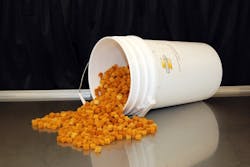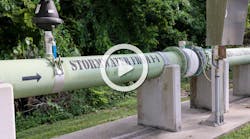Sponge Filtration Media Removes Zinc, Meets Benchmarks
This project's requirements were to meet or exceed the Oregon Department of Environmental Quality storm water permit benchmark for zinc using existing drainage infrastructure and adapting passive filtration methods. The permit requirements were to reduce total zinc at sample point to a geometric mean of less than 0.24 mg/L over four consecutive sample events.
The site is approximately 2.4 acres of totally impervious surface where about half consists of buildings with a mixture of metal and composite roofs. Buildings have galvanized gutters and downspouts connecting to main storm drainage pipe through cast iron underground pipelines. The remainder of the site is paved with asphalt and includes four concrete loading docks. A total of seven catch basins drain the paved area with each loading dock having one catch basin at its lowest point. All catch basins are connected to the same main drainage pipe and a sampling manhole has been installed at the edge of the property. All the roof runoff and pavement drains connect upstream of the sample manhole, the combined flow is analyzed and the result is submitted to the permit regulatory agency.
Company management had implemented a program of frequent parking lot sweeping and pressure washing of roofs and gutters, along with moving all identifiable zinc sources under cover. It also deployed non-woven fabric catch basin filters throughout the site. These measures brought the levels of suspended solids down to acceptable limits, but left the zinc levels at greater than 5 mg/L. Oregon Wire Products replaced the non-woven fabric filters with CleanWay catch basin filters and installed MetalZorb metals removal filtration elements in the catch basins that showed the highest concentration of zinc.
Through adapting a strategy of adding MetalZorb where zinc was highest, coating one of the metal roofs and keeping to an adaptive maintenance schedule, the permit requirement of four consecutive samples with an average zinc content of less than 0.24 mg/L were met. A waiver of further testing in the remaining permit cycle was achieved.


